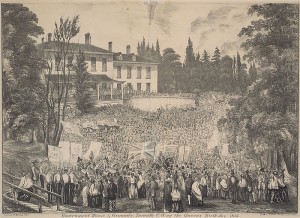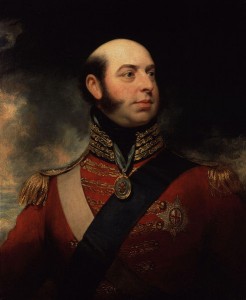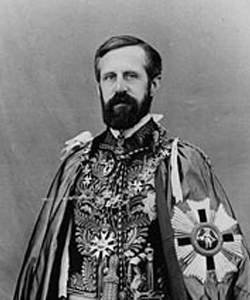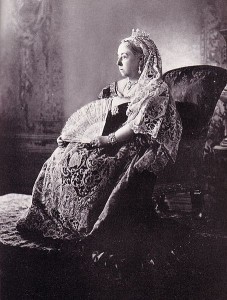This weekend, the Diamond Jubilee celebrations for Queen Elizabeth II that have been taking place in the United Kingdom and Commonwealth throughout 2012 will culminate in a magnificent river pageant on the Thames. The festivities mark the Queen’s six decade reign and the United Kingdom’s history as a naval power. The opulence of the planned flotilla also underscores the rarity of Diamond Jubilees.
There has only been one other comparable occasion in the history of the British Isles: The Diamond Jubilee of Elizabeth II’s great-great grandmother Queen Victoria in 1897. Victoria succeeded to the throne in 1837 at the age of eighteen and enjoyed the longest reign in British history. When she died in 1901, after nearly sixty-four years on the throne, the nineteenth century was already being described as the Victorian Era.

A Victoria Day celebration at First Government House in Toronto, 1854. The public holiday was originally a celebration of the Queen’s birthday before becoming a commemoration of a “Mother of Confederation” after her death in 1901.
The current Queen is the most well traveled monarch in history and takes her role as Head of the Commonwealth seriously. The modern royal family is therefore celebrating Elizabeth II’s Diamond Jubilee on an international scale with representatives visiting all the commonwealth realms. Prince Charles and the Duchess of Cornwall joined the Canadian celebrations, significantly visiting Canada over the Victoria Day holiday weekend. The international celebrations in 2012 highlight the Queen’s role as Head of a Commonwealth of equal nations.
Canadian involvement in the celebrations for Queen Victoria’s Diamond Jubilee was very different in 1897. The Queen had a personal connection to Canada. Her father, Prince Edward, Duke of Kent and Strathearn, did military service in British North America, overseeing the defenses surrounding the royal naval base in Halifax, Nova Scotia. The Prince was appointed Commander-in-Chief of the British Forces in North America in 1799 and gave his name to the future province of Prince Edward Island. Although there is no direct evidence that Prince Edward and his mistress Madame de St. Laurent had children during their time in British North America, there are Canadian families who claim descent from the couple.

Portrait of Queen Victoria’s father, Prince Edward, Duke of Kent and Strathearn by Sir William Beechey
In contrast to her father, Queen Victoria did not travel widely, leaving the British Isles on rare occasions such as a state visit to Napoleon III in France and family weddings in Germany. By the time of her Diamond Jubilee, the seventy eight year old Queen suffered increasing difficulties walking. The Thanksgiving service for her sixty year reign was held outside St. Paul’s cathedral because she could not climb to steps to go inside. For the British Empire to celebrate the Diamond Jubilee with Queen Victoria, representatives had to travel to London.
The presence of colonial premiers, diplomats and military regiments in London in 1897 made the Diamond Jubilee distinct from all previous celebrations of Queen Victoria’s reign. The Golden Jubilee of 1887 celebrated the Queen’s role as grandmother of Europe with the parade comprising of her illustrious children and grandchildren from across Europe. In contrast, the Diamond Jubilee celebrated Queen Victoria as the matriarch of a global Empire.

John Hamilton-Gordon, Earl of Aberdeen and Governor General of Canada at the time of Queen Victoria’s Diamond Jubilee
On June 22, 1897, the Diamond Jubilee Parade in London began with the Colonial Procession, headed by the Canadian delegation. Although Canada had been a self-governing Dominion since 1867, the country’s foreign affairs were managed by Great Britain and Canadians viewed themselves as part of the British Empire. When Lord Aberdeen, Governor General of Canada received the Queen’s Jubilee message that morning, “From my heart I thank my beloved people. May God bless them,” he responded, “The Queen’s most gracious and touching message, this moment received, shall be immediately made known to all your Majesty’s people throughout the Dominion and will stir afresh the hearts already full on this memorable day. We offer the glad tribute of loyal devotion and affectionate homage. God save and bless the Queen.”
In London, the Canadian cavalry rode five abreast at the Head of the Colonial Procession. Prime Minister Sir Wilfrid Laurier, an ardent monarchist who had received his knighthood from the Queen that morning, followed in a carriage. After the Prime Minister came a
detachment of the Toronto Grenadiers and Royal Canadian Highlanders. Representatives from the other regions of the British Empire, British and foreign royalty and finally, the Queen herself completed the parade. The festivities took place in London but Canada was well represented by the Prime Minister and the military.
Canada participated in the celebrations for both Queen Victoria’s and Queen Elizabeth II’s Diamond Jubilees. While the Empire gathered in London to celebrate Victoria in 1897, members of the royal family are traveling throughout the commonwealth in 2012 to join the worldwide festivities in honour of Elizabeth II.
